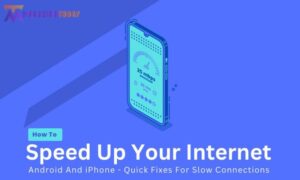If you’ve ever asked yourself, “Why is my data so slow?” you’re not alone. In today’s fast-paced digital world, slow mobile data can be incredibly frustrating, especially when you’re trying to stream, browse, or work on the go. Understanding the reasons behind sluggish data speeds and learning how to fix them can save you time, money, and plenty of headaches.
In this comprehensive guide, we’ll break down the possible causes of slow data speeds, offer tips to troubleshoot the issue, and share strategies to optimize your connection. If you keep wondering, “Why is my data so slow?” this guide is here to help.
Understanding Mobile Data: How Does It Work?


Before diving into the reasons behind slow data speeds, let’s take a quick look at how mobile data works. Your phone connects to the internet through your mobile carrier’s network, which relies on cell towers to transmit signals. The speed of your data depends on several factors, such as:
Network technology: 3G, 4G LTE, or 5G.
Signal strength: The number of bars on your phone.
Network congestion: How many people are using the network simultaneously.
Understanding these basics will help you diagnose issues and find effective solutions. So the next time you ask yourself, “Why is my data so slow?” you’ll know where to start.
Top Reasons Why Your Data Is Slow
Weak Signal Strength
A weak signal is one of the most common causes of slow mobile data. When your phone is far from the nearest cell tower or obstructed by buildings, trees, or hills, your signal strength drops. This can result in lower speeds or even a complete loss of connection. And you might think, “Why is my data so slow in this area?”
Network Congestion
During peak hours, like evenings or weekends, mobile networks can become congested. When too many users connect to the same cell tower, the available bandwidth is divided among them, leading to slower speeds. This is another reason you might ask, “Why is my data so slow right now?”
Data Throttling
Many carriers throttle (reduce) data speeds after you exceed your monthly data cap or during times of high network usage. This is especially common with unlimited plans that have a soft data limit. If your speeds slow down unexpectedly, you might wonder, “Why is my data so slow despite having unlimited data?”
Outdated Network Technology
If you’re using an older phone that only supports 3G or 4G LTE, you may experience slower speeds compared to users on 5G networks. The technology your phone uses significantly impacts your data speed. Ever wondered, “Why is my data so slow on an old phone?” This could be the reason.
Background Apps and Updates
Apps running in the background or automatic updates can consume a large amount of data without your knowledge, slowing down your connection. You might not notice it immediately, but it can lead to asking, “Why is my data so slow all of a sudden?”
Network Outages or Maintenance
Sometimes, slow speeds are due to issues on your carrier’s end. Scheduled maintenance, equipment failures, or natural disasters can disrupt services temporarily. During such times, you may think, “Why is my data so slow, even though everything looks fine on my end?”
Device Issues
Your phone’s hardware or software might be the culprit. A phone with outdated software, limited processing power, or insufficient storage can struggle to maintain fast data speeds. This can make you wonder, “Why is my data so slow even with a good signal?”
How to Troubleshoot Slow Data Speeds


Step 1: Check Your Signal Strength
Look at the signal bars on your phone.
Move to an area with better coverage, such as higher ground or an open space.
Step 2: Restart Your Phone
Restarting your phone can refresh your connection to the network.
This simple step often resolves minor issues.
Step 3: Test Your Speed
Use a speed test app to check your current download and upload speeds.
Compare the results to your carrier’s advertised speeds.
Step 4: Turn Airplane Mode On and Off
Enabling airplane mode and then disabling it can force your phone to reconnect to the network.
This can help you connect to a less congested cell tower.
Step 5: Update Your Device
Check for software updates on your phone.
Updated software can include bug fixes and performance improvements.
Step 6: Clear Cache and Background Apps
Close unused apps running in the background.
Clear the cache to free up resources.
Step 7: Contact Your Carrier
If you’ve tried everything and your data is still slow, reach out to your carrier for assistance.
They can check for outages or network issues in your area.
Tips to Boost Your Mobile Data Speed
Upgrade Your Plan
If data throttling is the issue, consider upgrading to a plan with a higher data cap or priority access. Many carriers offer premium plans with faster speeds and less throttling.
Switch to a New Carrier
If your current carrier’s coverage is poor in your area, switching to another provider may solve the problem. Research which carriers have better signal strength and speed in your location.
Invest in a Signal Booster
Signal boosters amplify your phone’s signal, improving speed and reliability. They’re especially useful in rural areas or inside buildings with poor reception.
Use Wi-Fi Whenever Possible
Connecting to Wi-Fi can offload your data usage, especially in areas with slow mobile networks. Make sure to use secure networks to protect your data.
Switch to a 5G Device
If you’re using an older phone, upgrading to a 5G-enabled device can significantly enhance your data speeds.
Limit Background Data Usage
Go to your phone’s settings and restrict background data for apps.
Disable automatic updates or set them to occur over Wi-Fi only.
Use Data-Saving Features
Many phones and apps offer data-saving modes that compress data or reduce usage. Enable these features to improve performance.
How to Prevent Slow Data in the Future


Monitor Your Data Usage
Regularly check your data usage to avoid exceeding your limit.
Many carriers provide apps to track usage in real time.
Choose the Right Carrier
Research carriers’ coverage maps and user reviews before committing to a plan.
Consider prepaid or postpaid plans based on your needs.
Keep Your Device Updated
Install updates as soon as they’re available to ensure optimal performance.
Optimize Your Phone Settings
Turn off features like GPS, Bluetooth, or Wi-Fi when not in use.
Reduce the resolution for streaming videos.
When to Seek Professional Help
If you’ve tried all the above steps and your data is still slow, it might be time to seek professional help. Contact your carrier for a detailed analysis of your account and network connection. If the issue persists, a tech expert can diagnose hardware or software problems with your device.
FAQs
1. How do I know if my data is being throttled?
If your data slows down significantly after you’ve used a certain amount of data, your carrier might be throttling your speeds. Check your plan details or contact your carrier for confirmation.
2. Does 5G always mean faster data?
While 5G generally offers faster speeds, your experience depends on factors like signal strength, network congestion, and your device’s compatibility.
3. Can a VPN improve my data speed?
A VPN doesn’t inherently improve data speed but can bypass network throttling in some cases. However, it may also slow down your connection due to encryption overhead.
4. Why is my data slow even with full bars?
Full bars indicate strong signal strength but don’t account for network congestion, throttling, or device issues. Run a speed test to identify the cause.
5. Can weather affect mobile data speeds?
Yes, severe weather conditions can disrupt cell towers and reduce signal quality, leading to slower data speeds.
Conclusion
Slow mobile data is an inconvenience, but understanding the causes and solutions can help you get back to browsing, streaming, and working efficiently. Whether it’s optimizing your phone’s settings, upgrading your plan, or switching carriers, there are plenty of ways to improve your connection. If you’ve ever asked, “Why is my data so slow?” the answers and solutions are now at your fingertips. With these tips and tricks, you’ll be well-equipped to tackle slow data speeds and enjoy a seamless online experience.






